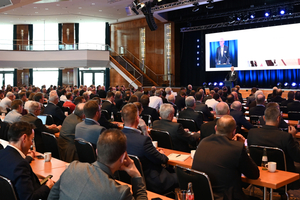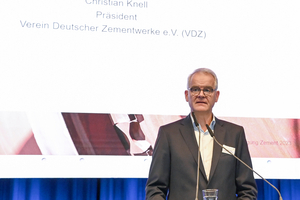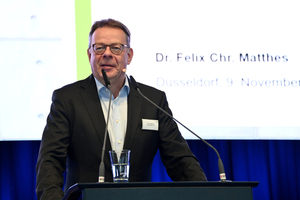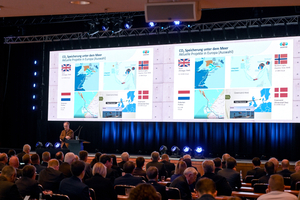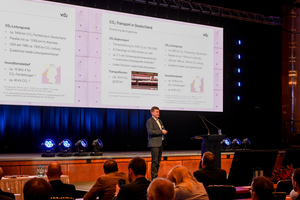VDZ’s Annual Cement Conference 2023: “Mirror on the most important issues of our time”
VDZ President Christian Knell welcomed the Annual Cement Conference 2023 (Jahrestagung Zement) with clear words: The world is currently in permanent crisis mode. Climate change, global conflicts and inflation are having an impact on all areas of life and are putting existing structures to the test. For the cement industry, this results in the urgent task of moving towards climate neutrality – and at a rapid pace. According to Knell, there is no alternative to this step. Much has already been set in motion in the cement industry, but the industry is treading a fine line on the path to CO2 neutrality, for example when it comes to competitiveness with manufacturers in countries that give less priority to climate protection. The cement industry now needs to rethink the tried and tested. With this in mind, experts from the industry as well as from areas such as marine research, chemistry, energy and cybercrime spoke at the Annual Cement Conference 2023 as a “mirror on the most important topics of our time”. An overview.
Carbon management strategy: the path to CO2 neutrality
Dr Felix Christian Matthes presented the national and international carbon management strategy and its implications for the cement industry as a decisive measure for achieving climate neutrality. The positive news first: despite all the current geopolitical upheavals, climate policy and the path to climate neutrality remain an international concern in which many countries are pulling in the same direction - albeit with very different specifications of the targets, binding nature and over very different time horizons between 2040 and 2070.
While 2045 is generally regarded as the decisive year for Germany in terms of climate neutrality, this will take effect much earlier in the ETS sectors: the last CO2 certificates will be issued in 2038. Matthes emphasizes emphatically: “These regulations are binding!” If the targets cannot be met, this will result in high penalties.
This raises the question: How do we get through the transformation phase? Six central strategies should pave the way for a successful transformation to climate neutrality:
Transformative options: Paths must be opened
Unsustainable options: Actively shape the exit
Initiate necessary adjustments to infrastructure with sufficient lead times
Necessary value chains: Accompany ramp-up in good time
Timely availability of innovations; avoid innovation dilemmas
Consider international learning and diffusion processes
As aspects such as energy efficiency, renewable energies, electrification or, particularly in industry, carbon capture strategies are the key implementation strategies on the path to climate neutrality, these should be set in motion by implementation instruments such as specific incentive mechanisms or better infrastructure planning and regulation. For example, the measures are intended to save 7-10 million t/a of CO2 in the cement industry by 2035 and 13-16 million t/a in the longer term, and 2 million t/a of CO2 in the lime industry by 2035 and 4-6 million t/a in the longer term.
CO2 storage under the North Sea: a suitable (transitional) solution?
The question of how the path to complete CO2 neutrality in the cement industry can be made as climate-friendly as possible was also debated at the VDZ annual conference from the perspective of marine research. Klaus Wallmann, GEOMAR Helmholtz Center for Ocean Research Kiel, spoke on the topic of “CCS and CO2 storage under the North Sea”. The functional principle is that CO2 is separated from industrial plants, liquefied under pressure, transported by ship or pipeline and then stored in porous sandstone formations under the North Sea.
Wallmann emphasizes: CO2 storage in submarine formations in the North Sea has already been successfully implemented on an industrial scale for over 25 years, and the implementation of further industrial storage projects in the Norwegian, Danish, Dutch and English North Sea is also planned for 2024-2027 – however, industrial storage projects in the German North Sea have not yet been possible due to the Act on the Demonstration of Permanent Storage of Carbon Dioxide (KSpG).
According to the ocean researcher, however, there is great potential in Germany in particular: at 1-6 Gt of CO2, the storage capacity in the German North Sea is high, and potentially suitable storage sites are also available, meaning that a large proportion of the amount of CO2 to be captured in Germany in the future could be stored there.
Extensive research has already been carried out into possible environmental risks over the past two decades. A major risk factor here is CO2 leakage, for example at old boreholes, which can lead to acidification of the groundwater. Other factors include induced seismicity and noise and its impact on marine mammals and other marine life. However, suitable measures – good sealing and cementing of boreholes, the selection of suitable locations and pressure limits or the choice of passive instead of active seismic – could greatly reduce all risk factors. This is also demonstrated by a CO2 release experiment on the seabed at the Norwegian Sleipner storage site. Here, with high emission rates of 30 t/a CO2 over an area of 50 m2, the bottom water is acidified – due to the high CO2 content in the North Sea water and rapid tidal currents, acidification beyond this area is no longer detectable.
Here Wallmann once again brings the German North Sea into play: as there are only a few old boreholes here (approx. 70 out of a total of 17000), less natural seismicity, stricter regulations and less transport infrastructure, the environmental risks in the German EEZ are even lower than with storage in neighboring countries. The speaker summarized: “CCS with CO2 storage in the North Sea is not a high-risk technology.” The consensus in academic research is that the benefits for climate protection are greater than the burden on nature conservation, and that environmental risks can be further minimized by selecting suitable storage sites, comprehensive environmental monitoring and suitable regulations (KSpG).
CO2 neutrality: it won‘t work without infrastructure
Manuel Mohr and Johannes Ruppert, both from the German Cement Works Association, spoke about infrastructure as a further decisive step towards the decarbonization of cement and concrete at the Annual Cement Conference. The speakers presented preliminary results of a new VDZ study “Requirements for a CO2 infrastructure in Germany”, which is due to be published in March 2024. According to the presenters, initial approaches can be identified, but a consistent overall concept for relevant CO2 sources is still lacking. The VDZ study is intended to clearly show the need for action from an industry perspective and consequently provide input for the national carbon management strategy.
The study identifies the following infrastructure requirements for CO2 transportation:
CO2 sources in Germany: cement, lime, waste incineration
Multimodal CO2 transport in Germany including transit volumes: Pipelines, rail, ship
CO2 sinks: storage projects and hubs in Europe; prospects for use
Milestone years: 2030, 2035, 2040, 2045; 2 scenarios for climate neutrality (2040 and 2045)
CO2 capture ramp-up: Bottom-up & Top-down; CCS, BECCS, CCU
Carbon capture: additional energy requirements
CO2 transport by rail
The study shows that as of today, 27 out of 33 cement plants and 11 out of 33 lime plants have a rail siding. An assessment of suitability must be made on a site-specific basis, but in most cases the “last kilometer” is still required for additional shunting and loading tracks. When extending tracks for waste incineration plants in urban areas, the problem of a lack of space arises.
Inland waterways for CO2 transportation
Cement plants with port connections can be found in Hanover, Höver, Wiesbaden, Lengfurt and Karlstadt, while lime plants close to the river are Walhalla, Istein and Saal. As with CO2 transportation by rail, a site-specific assessment must be carried out. High or low water poses a challenge here. CO2 exports can begin at the North Sea ports before 2030.
CO2 transport via pipeline
According to the study, corridors and possible connections within a 50 km radius also appear to be suitable for connecting concentrated sources to CO2 pipelines. Almost all cement and lime plants in Germany could be connected within a 50 km radius, and 163 out of 177 waste incineration plants are within this radius. However, in addition to the site-specific assessment, a calculation of the costs and effort involved in the connection would also have to be made.
Possible CO2 requirements from the chemical industry
According to the Chemistry4Climate study, there could be a significant demand for CO2 from the chemical industry from 2045. However, this would be accompanied by very high renewable energy requirements, and the timing of the ramp-up and regulations on regional distribution are still uncertain. Carbon Capture & Utilization will play a role to connect CO2 sources and sinks on a regional level, but is not part of the infrastructure modelling.
CO2 storage sites and hubs in Europe
For the year 2030, 36 projects for CO2 storage with injection capacity (110 Mt/a CO2, of which 35 Mt/a CO2 in the EU) are currently planned in the European Economic Area and UK. In addition, 13 locations are planned as possible further CO2 storage sites, and 20 Mt/a of CO2 could be stored in the German North Sea. In addition, planned and possible CO2 hubs would open up a transit capacity of 125 Mt/a CO2.
Climate neutrality 2040 vs. 2045
Johannes Ruppert compared two climate neutrality scenarios from the VDZ study. In scenario 1 (climate neutrality 2040), transport will initially be exclusively by train (5 Mt/a CO2 with stable transport contributions), from 2028 there will be a pipeline connection (initially 3 Mt/a CO2), which will enable pipeline transport from the aforementioned 50-kilometer radius of the long-distance pipelines from 2033. In the long term, from 2045, 90% of CO2 will be transported via pipelines. In this scenario, negative emission contributions are possible via the BECCS process with -10 Mt/a CO2 after 2040 (primarily biomass from waste).
In scenario 2 (climate neutrality 2045), the pipeline connection does not take place until 2033, 5 years later, which results in a longer-term use of train and ship transport and a later achievement of the climate neutrality target. In this case, the demand for train or ship transport doubles to up to 9 Mt/a CO2. If the pipeline connection does not take place until 2033, climate targets will most likely not be met.
CO2 infrastructure and climate neutrality: 8 cornerstones
Mohr and Ruppert summarized: From the industry’s point of view, there are 8 prerequisites for achieving climate neutrality.
Legal framework for CCUS und carbon management strategy in 2024
Development of CO2 pipeline network & infrastructure 2028 to 2037: cooperation of CO2 grid operators
CO2-free energy and power grid expansion: connecting to locations and creating acceptance
Enormous acceleration in terms of planning and approval, as well as support for specialist personnel
Promotion of infrastrucure investments, regulated costs & access for users
Technical regulations for international cooperation and cross-border CO2 transport
Increasing parallelization of CO2 and H2 infrastructure ramp-up
Ensure access to CO2 storage facilities, including in the German North Sea; manage the integration of CCU
International VDZ Congress 2024
The international VDZ Congress 2024 will take place from November 6 to 8, 2024 at the Maritim Hotel Düsseldorf/Germany.

